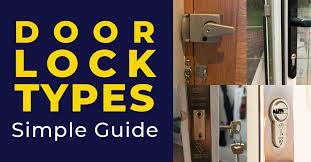Our guide will assist you in determining the sort of lock that is put in your home if you are unsure of what locks are on your front and rear doors. Locks come in a wide variety of styles, including door locks, window locks, and bicycle locks. Knowing which lock type will suit your needs the best might be challenging given the wide variety available. We’ve developed this helpful guide that covers the primary door lock types and their advantages and disadvantages because there are so many different lock kinds and brand names available. At lockpickmall.com, you can also get sufficient Lock Picking Tools.
Deadbolt Locks
One of the safest types of locks is the deadlock. Either a key or a thumb turn can be used to lock and unlock them. The pin is inserted into the mortise beneath the doorjamb lock plate when the key is turned to lock the door. On exterior doors that need to be secure, such front and back doors, deadbolts are frequently installed. The two most common kinds of deadbolts are. A single cylinder lock has a cylinder that is turned on the inside and off with a thumb turn and a key on the outside. A double cylinder deadbolt has an inside and an outer cylinder, both of which need a key. Most deadlocks use tumbler locks as their locking mechanism, which are frequently found in cylinder locks.
Padlocks
Just padlocks are portable locks that are typically never attached permanently to anything. They come in a range of sizes and secure objects of interest with shackles. The lock body, the striker, and the locking mechanism are the three basic components of both of the two primary types of padlocks—key locks and combination locks. Padlocks are simple to pick since they can be forcedly opened using tools like bolt cutters, hammers, or drills, or covertly opened using tools like a lockpick or shim. In order to unlock a combination padlock, a set of digits must be input in the correct order.
Door Knob Locks
As the primary locking mechanism for inner and exterior doors, knob locks are most frequently encountered in residential buildings. The locking mechanism is controlled by a rotating knob on one side of the door handle and a lock cylinder on the other. These locks should never be used on exterior doors without a secondary lock, such as a deadbolt, as they are susceptible to brute force attacks. By using a hammer to remove the knob and pliers to weaken the locking mechanism, it is easy to get around these locks. They are simple to select and caulk as well.
Lever Handle Locks
Usually, business buildings’ inner doors have these locks installed. To release the bolt, they employ a lever that may be moved upward or downward. They have a cylinder on one side and a turnable knob on the other, just as knob locks. They are perfect for business settings and handicapped accessible places since they open easily with a lever.
Cam Locks
A typical form of latch seen in file cabinets, lockboxes, and other low-security appliances is the cam lock. These locks spin a little flat metal tail piece known as a “cam” in and out of the door’s slot using a key. They have a wide range of cams and can revolve either clockwise or counterclockwise. Typically, tumbler or tubular locking mechanisms—both of which are exceedingly simple to pick—are used in cam locks.
Visit lockpickmall.com to see our wide variety of Locksmith Tools if you’re curious about the many types of locks.

